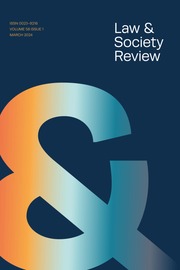Article contents
On the Radar: System Embeddedness and Latin American Immigrants' Perceived Risk of Deportation
Published online by Cambridge University Press: 01 January 2024
Abstract
Drawing on in-depth interviews with 50 Latin American immigrants in Dallas, Texas, this article uncovers systematic distinctions in how immigrants holding different legal statuses perceive the threat of deportation. Undocumented immigrants recognize the precarity of their legal status, but they sometimes feel that their existence off the radar of the US immigration regime promotes their long-term presence in the country. Meanwhile, documented immigrants perceive stability in their legal status, but they sometimes view their existence on the radar of the US immigration regime as disadvantageous to their long-term presence in the country. The article offers the concept of system embeddedness—individuals' perceived legibility to institutions that maintain formal records—as a mechanism through which perceived visibility to the US immigration regime entails feelings of risk, and perceived invisibility feelings of safety. In this way, the punitive character of the US immigration regime can overwhelm its integrative functions, chilling immigrants out of opportunities for material and social well-being through legalization and legal status. More broadly, system embeddedness illuminates how perceived visibility to a record-keeping body that combines punitive and integrative goals represents a mechanism of legal stratification for subordinated populations—even absent prior punitive experiences with other social control institutions that might otherwise be thought to trigger their system avoidance.
- Type
- Articles
- Information
- Copyright
- © 2020 Law and Society Association.
Footnotes
I am grateful to Stefanie DeLuca and Kathryn Edin, the co-principal investigators of the How Parents House Kids Project (HPHK), for their generous leadership; the HPHK researchers for their teamwork; and the Annie E. Casey Foundation and the John D. and Catherine T. MacArthur Foundation for their financial support. I acknowledge additional financial support from the National Science Foundation, and the Radcliffe Institute for Advanced Study at Harvard University. Monica Bell, Matthew Clair, Tomás Jiménez, and Helen Marrow graciously offered incisive comments on previous versions of this article. I also thank Sarah Brayne, Hana Brown, Hilario Dominguez, Filiz Garip, Shannon Gleeson, Beth Lyon, Tiffany Joseph, Mario Small, Jessica Tollette, Mary Waters, Bill Wilson, and Alix Winter, as well as the Law & Society Review editor Rebecca Sandefur and anonymous reviewers, for helpful feedback or support on this project. Audiences at Cornell University, Harvard University, Rice University, Stanford University, Yale Law School, and the Universities of Michigan, Pennsylvania, Toronto, and Wisconsin also provided helpful suggestions. Any errors are my own.
References
REFERENCES
- 56
- Cited by


